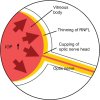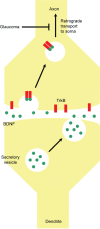Neuroprotective therapies for glaucoma
- PMID: 25792807
- PMCID: PMC4362661
- DOI: 10.2147/DDDT.S80594
Neuroprotective therapies for glaucoma
Abstract
Glaucoma is the second leading cause for blindness worldwide. It is mainly caused by glaucomatous optic neuropathy (GON) characterized by retinal ganglion cell loss, which leads to visual field defect and blindness. Up to now, the main purpose of antiglaucomatous therapies has been to lower intraocular pressure (IOP) through surgeries and medications. However, it has been found that progressive GON is still present in some patients with effective IOP decrease. Therefore, risk factors other than IOP elevation, like neurotrophin deprivation and excitotoxicity, contribute to progressive GON. Novel approaches of neuroprotection may be more effective for preserving the function of the optic nerve.
Keywords: glaucoma; glaucomatous optic neuropathy; neuroprotection; retinal ganglion cells.
Figures





Similar articles
-
[The dawn of neuroprotective therapy for glaucomatous optic neuropathy].Nippon Ganka Gakkai Zasshi. 2001 Dec;105(12):866-83. Nippon Ganka Gakkai Zasshi. 2001. PMID: 11802458 Review. Japanese.
-
Disease progression and the need for neuroprotection in glaucoma management.Am J Manag Care. 2008 Feb;14(1 Suppl):S15-9. Am J Manag Care. 2008. PMID: 18284311 Review.
-
[Retinal ganglion cells death in glaucoma--mechanism and potential treatment. Part I].Klin Oczna. 2007;109(7-9):349-52. Klin Oczna. 2007. PMID: 18260296 Review. Polish.
-
Neuroprotective Strategies in Glaucoma.Curr Pharm Des. 2016;22(14):2178-92. doi: 10.2174/1381612822666160128144747. Curr Pharm Des. 2016. PMID: 26818878 Review.
-
An experimental basis for implicating excitotoxicity in glaucomatous optic neuropathy.Surv Ophthalmol. 1999 Jun;43 Suppl 1:S142-50. doi: 10.1016/s0039-6257(99)00017-x. Surv Ophthalmol. 1999. PMID: 10416757 Review.
Cited by
-
Bilberry extract administration prevents retinal ganglion cell death in mice via the regulation of chaperone molecules under conditions of endoplasmic reticulum stress.Clin Ophthalmol. 2017 Oct 11;11:1825-1834. doi: 10.2147/OPTH.S145159. eCollection 2017. Clin Ophthalmol. 2017. PMID: 29066860 Free PMC article.
-
Current perspective of neuroprotection and glaucoma.Clin Ophthalmol. 2015 Nov 11;9:2109-18. doi: 10.2147/OPTH.S80445. eCollection 2015. Clin Ophthalmol. 2015. PMID: 26635467 Free PMC article. Review.
-
Molecular Mechanisms of Glaucoma Pathogenesis with Implications to Caveolin Adaptor Protein and Caveolin-Shp2 Axis.Aging Dis. 2024 Oct 1;15(5):2051-2068. doi: 10.14336/AD.2023.1012. Aging Dis. 2024. PMID: 37962455 Free PMC article. Review.
-
Safety and Efficiency of Trabectome-mediated Trabecular Meshwork Ablation for Chinese Glaucoma Patients: A Two-year, Retrospective, Multicentre Study.Chin Med J (Engl). 2018 Feb 20;131(4):420-425. doi: 10.4103/0366-6999.225050. Chin Med J (Engl). 2018. PMID: 29451146 Free PMC article.
-
Neurodegeneration and Neuroprotection in Glaucoma.Yale J Biol Med. 2016 Mar 24;89(1):73-9. eCollection 2016 Mar. Yale J Biol Med. 2016. PMID: 27505018 Free PMC article. Review.
References
-
- Casson RJ, Chidlow G, Wood JP, Crowston JG, Goldberg I. Definition of glaucoma: clinical and experimental concepts. Clin Experiment Ophthalmol. 2012;40(4):341–349. - PubMed
-
- Shiose Y, Kitazawa Y, Tsukahara S, et al. Epidemiology of glaucoma in Japan – a nationwide glaucoma survey. Jpn J Ophthalmol. 1991;35(2):133–155. - PubMed
-
- Iwase A, Suzuki Y, Araie M, et al. Tajimi Study Group, Japan Glaucoma Society The prevalence of primary open-angle glaucoma in Japanese: the Tajimi Study. Ophthalmology. 2004;111(9):1641–1648. - PubMed
-
- Narayanaswamy A, Baskaran M, Zheng Y, et al. The prevalence and types of glaucoma in an urban Indian population: the Singapore Indian Eye Study. Invest Ophthalmol Vis Sci. 2013;54(7):4621–4627. - PubMed
Publication types
MeSH terms
Substances
LinkOut - more resources
Full Text Sources
Medical

